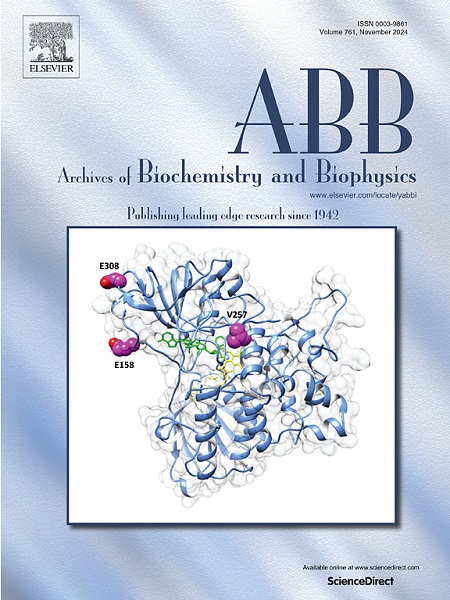阴离子心磷脂能稳定透明质酸合成酶的跨膜区域,并促进催化相关的动态变化。
IF 3.8
3区 生物学
Q2 BIOCHEMISTRY & MOLECULAR BIOLOGY
引用次数: 0
摘要
透明质酸(HA)是一种对细胞过程至关重要的糖胺聚糖,在医学、制药和化妆品领域的应用日益广泛。在大多数生物体内,膜整合 I 类透明质酸合成酶(HAS)催化 HA 的合成,但 HAS 与脂质相互作用影响 HAS 催化的分子机制仍不清楚。本研究采用粗粒度分子动力学模拟结合降维技术,揭示了脂质与马氏链球菌 HAS(SeHAS)之间的相互作用。通过梯度膜模拟确定,HA 合成至少需要 67% 的心磷脂。阴离子心磷脂能稳定 SeHAS 的阳离子跨膜区域,从而保持其构象。此外,高动态的心磷脂需要调节 HAS 中与催化相关的运动,从而促进 HA 的合成。这些发现不仅为了解 HAS 的生理功能提供了重要的分子见解,也为开发用于生产 HA 的细胞工厂和酶催化剂提供了重要依据。本文章由计算机程序翻译,如有差异,请以英文原文为准。

Anionic cardiolipin stabilizes the transmembrane region of hyaluronan synthase and promotes catalysis-relevant dynamics
Hyaluronic acid (HA) is a glycosaminoglycan essential for cellular processes and finding increasingly applications in medicine, pharmaceuticals, and cosmetics. While membrane-integrated Class I hyaluronan synthase (HAS) catalyzes HA synthesis in most organisms, the molecular mechanisms by which HAS-lipid interactions impact HAS catalysis remain unclear. This study employed coarse-grained molecular dynamics simulation combined with dimensionality reduction to uncover the interplay between lipids and Streptococcus equisimilis HAS (SeHAS). A minimum of 67 % cardiolipin is necessary for HA synthesis, as determined through simulations using gradient-composed membranes. The anionic cardiolipin stabilizes the cationic transmembrane regions of SeHAS and thereby maintains its conformation. Moreover, the highly dynamic cardiolipin is required to modulate the catalysis-relevant motions in HAS and thus facilitate HA synthesis. These findings provide molecular insights essential not only for understanding the physiological functions of HAS, but also for the development of cell factories and enzyme catalysts for HA production.
求助全文
通过发布文献求助,成功后即可免费获取论文全文。
去求助
来源期刊

Archives of biochemistry and biophysics
生物-生化与分子生物学
CiteScore
7.40
自引率
0.00%
发文量
245
审稿时长
26 days
期刊介绍:
Archives of Biochemistry and Biophysics publishes quality original articles and reviews in the developing areas of biochemistry and biophysics.
Research Areas Include:
• Enzyme and protein structure, function, regulation. Folding, turnover, and post-translational processing
• Biological oxidations, free radical reactions, redox signaling, oxygenases, P450 reactions
• Signal transduction, receptors, membrane transport, intracellular signals. Cellular and integrated metabolism.
 求助内容:
求助内容: 应助结果提醒方式:
应助结果提醒方式:


